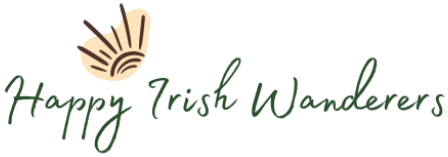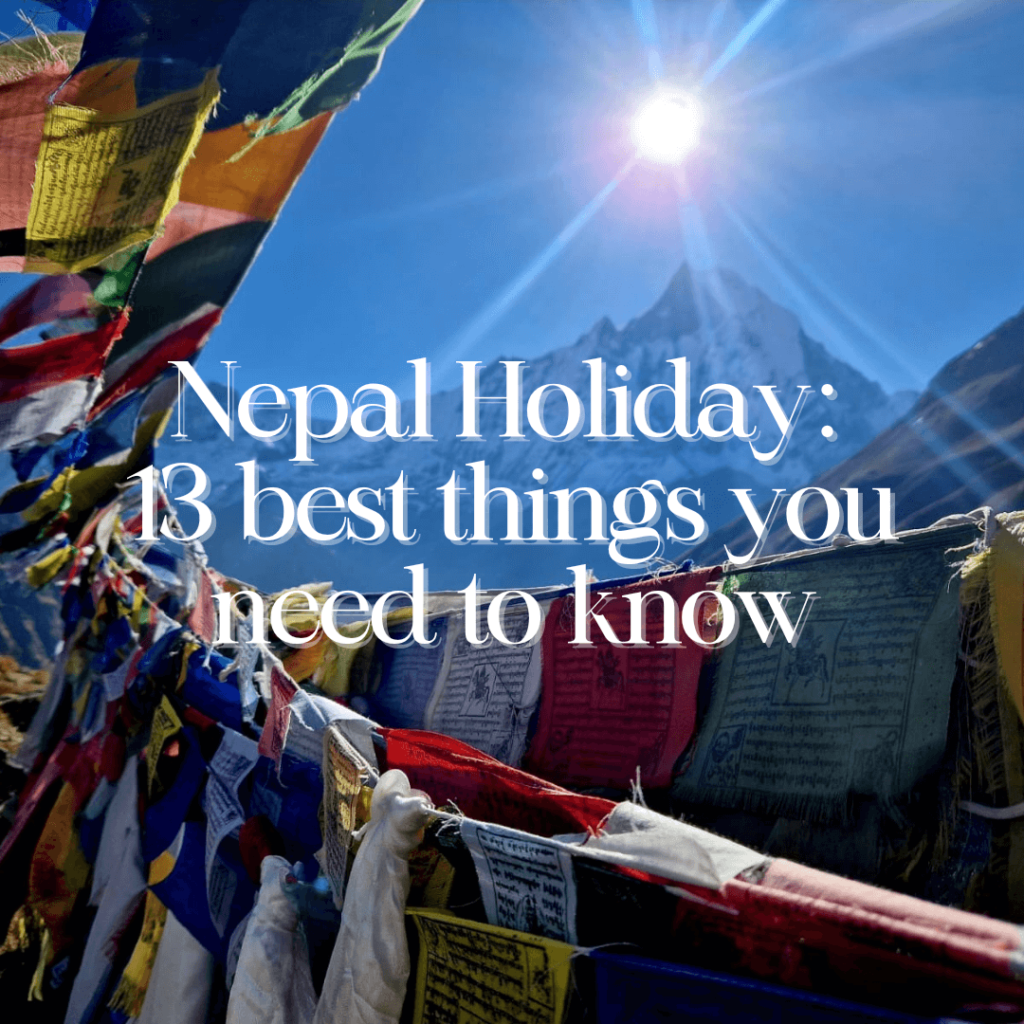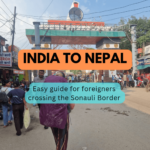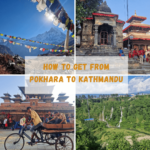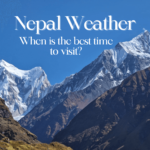Last updated on November 19th, 2024 at 10:56 am
Welcome to your ultimate Nepal travel guide, designed to make your Nepal holiday an unforgettable experience.
Nepal is famous for being home to Mount Everest, the world’s highest peak, and its rich cultural heritage. It is also renowned for trekking, wildlife, and being the birthplace of Lord Buddha – Now that sounds like a pretty impressive holiday destination right?!
This Nepal holiday guide provides comprehensive information on all the essential questions around visa information, the best Nepal attractions, the best time to visit Nepal, advising your ideal Nepal budget while sharing our own Nepal holiday spending, and tackling the vital questions if Nepal is safe to visit or even worth visiting.
We are here to help with your visit to Nepal and offer you a complete Nepal holiday guide, so let’s get into it.
1. Do You Need a Nepal Visa?
Most nationalities (e.g., the U.S., UK, Canada, Australia, and most European countries) can obtain a visa upon arrival at Tribhuvan International Airport (Kathmandu) or at land border entry points. This visa is available for up to 15, 30, or 90 days, depending on the fee you pay.
15 Days – 30 USD
30 Days – 50 USD
90 Days – 125 USD
Citizens of India do not need a visa to enter Nepal. But, if you are from India you probably already know this!
Citizens of China can enter Nepal without a visa for a stay of up to 30 days.
Before you travel to Nepal, we recommend double-checking the exact requirements on the official website of Nepal’s Department of Immigration.
2. What are the Best Attractions During Your Nepal Holiday?
The top attractions in Nepal are centered around its unbelievable landscapes and rich culture.
Just a heads up, if you are not interested in mountains, lakes, and hiking you may be very disappointed with your Nepal holiday!
Let’s look at some of the best things to do when visiting Nepal.
Kathmandu Valley
The Kathmandu Valley is home to several UNESCO World Heritage Sites, ancient temples, palaces, and a rich cultural history.
Top places to visit in Kathmandu include:
Durbar Squares (Kathmandu, Bhaktapur, and Patan): Ancient palaces, temples, and squares showcasing Nepalese architecture and history.
Garden of Dreams: A tranquil, beautifully landscaped area offering you a break from the bustling city. This might be very much welcomed after a day dodging traffic around the city!
Swayambhunath (Monkey Temple): A hilltop stupa with panoramic views of Kathmandu and a major pilgrimage site. Warning: hold on tight to your belongings around these monkeys.
Pashupatinath Temple: One of the holiest Hindu temples, located on the banks of the Bagmati River.
Boudhanath Stupa: One of the largest stupas in the world, a focal point for Tibetan Buddhism. What an impressive sight to witness.
Mount Everest & the Khumbu Region
You probably know that Nepal is home to the majestic Mount Everest, and for many, this is the primary reason to visit.
Rest assured, whether you’ve decided to trek to Basecamp or take in the breathtaking views from a nearby viewpoint, you won’t be disappointed.
Witnessing this spectacular sight is nothing short of awe-inspiring. Let’s take a look at where to get the best Mount Everest views:
Everest Base Camp Trek: This is one of the most famous treks in the world, taking you to the base of Mount Everest, with breathtaking views of the Himalayas. It doesn’t get more adventurous than this….well maybe if you climb to the summit…but that’s another level altogether!
Kala Patthar: Kala Patthar offers one of the best viewpoints of the summit of Mount Everest and can be combined with the Mount Everest Base Camp trek. This viewpoint offers a close-up view of Mount Everest and is popular because Mount Everest is not visible from Base Camp.
Namche Bazaar: A picturesque Sherpa village that serves as a base for Everest trekkers, where trekkers can enjoy local markets and stunning views. Sounds like the perfect spot to acclimatize!
Pokhara
Next on our list of best attractions in Nepal is where we spent most of our time during our Nepal holiday – Pokhara.
Pokhara is a charming city famous for its natural beauty, adventure sports, and relaxed vibe.
Phewa Lake: A beautiful lake where you can rent a boat or simply relax by the shore. You can’t miss it, Pokhara is centered around this stunning lake.
Sarangkot: A popular viewpoint to see sunrise over the Himalayas – the Annapurna Range. Consider taking a 3-hour private Sarangkot sunrise tour – from only $10 per person!!
World Peace Pagoda: A Buddhist stupa offering panoramic views of Phewa lake and surrounding mountains. Basically, everywhere in Pokhara offers spectacular views!
Annapurna Mountain Range: Pokhara is a gateway to trekking in the Annapurna region, which offers some of the best trekking experiences in the world. Keep reading for more information on this unbelievable trekking experience.
Make sure to check out our Pokhara travel guide for all our top tips and hidden gems to experience in this stunning part of Nepal.
Annapurna Range
Leading on nicely to our next Nepal attraction – the Annapurna Range. This Nepal hike is a classic trek offering differing landscapes, from subtropical forests to alpine deserts, and views of several peaks above 8,000 meters.
The Annapurna Base Camp trek (ABC) is also known as the “Teahouse trek” as it provides opportunities to explore traditional villages such as:
Chhomrong (2,170m / 7,120ft): Chhomrong is a small village in the heart of the trek, offering spectacular views of the famous Annapurna peaks. The village is a cultural highlight, as it is mostly inhabited by the Gurung people. Enjoy connecting with and learning from the local people to add to your already fantastic Annapurna experience.
Bamboo (2,310m / 7,580ft): Bamboo is a small village surrounded by dense bamboo and forested areas. This is one of the more remote sections of the trek.
Deurali (3,230m / 10,600ft): Deurali is a high-altitude village and one of the final stops before reaching Annapurna Base Camp. From here, trekkers begin to experience the harsher, more rugged terrain as they approach the high-altitude sections of the Annapurna Region.
Annapurna Base Camp (4,130m / 13,550ft): The ultimate highlight of the trek, Annapurna Base Camp lies at the heart of the Annapurna mountain range. Surrounded by towering peaks, the Base Camp offers an unparalleled panoramic view of the high Himalayas. Arrive for sunrise for some of the best views you will ever witness, plus, hiking through the moonlit mountain ranges is a pretty out-of-this-world experience!
Hot Springs at Jhinu Danda: Located on the way back down from Annapurna Base Camp, Jhinu Danda is home to natural hot springs. After days of trekking, these hot springs are a wonderful place to relax and unwind while enjoying the surrounding lush forests and river views. Just note that you will have to walk down (thus back up) more steps to get to enjoy these hot springs – but it’ll be worth it!
We absolutely loved this Nepal trek, staying in local villages along the way and enjoying the local food truly added to this unique Himalayan experience.
Check out our socials to see how we got on:
Chitwan National Park
A UNESCO World Heritage Site, Chitwan is one of Nepal’s most famous wildlife destinations. It is from this Nepal attraction that you can experience:
Jungle Safaris: The primary attraction of Chitwan National Park is its wildlife, and a jungle safari is the best way to explore it. Along with elephants and sloth bears, it is in Chitwan NP that you can spot the much sought-after Bengal tigers and one-horned rhinos.
Canoe Safari: Taking a canoe ride down the Rapti River or the Karnali River gives you the chance to spot aquatic animals like crocodiles (especially the mugger crocodile) and freshwater dolphins. You can also enjoy birdwatching along the banks of the river.
Tharu Culture: Chitwan is home to the indigenous Tharu people, who have their own unique culture and traditions. A visit to a Tharu village provides a fascinating cultural experience. Learn about the indigenous Tharu people, their culture, and traditional customs.
Lumbini
Lumbini, is one of the most important pilgrimage sites for Buddhists worldwide, as it is the birthplace of Siddhartha Gautama, who later became the Buddha.
We arrived in Nepal to Sonauli by land border from India. Shortly after crossing the border at Sonauli you will come to the next town – Lumbini. If you are considering crossing at the Sonauli Border you can find all the information you need from our India to Nepal border crossing travel guide.
Our first stop was Lumbini, the birthplace of Buddha – not a bad first attraction to visit on our Nepal holiday!
Maya Devi Temple: The exact spot where Buddha was born. It is dedicated to Queen Maya, Buddha’s mother, and is considered one of the most sacred places in the Buddhist world. The temple houses an ancient stone marker that marks the spot where Siddhartha Gautama was born.
Lumbini Gardens: A peaceful complex of temples, monasteries, and ponds. The peaceful environment makes it a popular spot for quiet reflection in this significant part of the world.
The World Peace Pagoda: The Peace Pagoda is a prominent landmark near the Maya Devi Temple and its striking white structure is visible from far away. The pagoda represents peace, unity, and the global spread of Buddhism.
Why not visit Bhutan while you are in this part of the world? Click on the link below for more details.
3. Nepal Weather: What is the Best Time to Visit Nepal?
The best time to visit Nepal depends on what you’re hoping to do, but generally, the most popular seasons are autumn (September to November) and spring (March to May).
Autumn is considered the best season to visit Nepal. Monsoon season can be quite dangerous in Nepal due to the high risk of landslides. We visited Nepal just after the 2024 landslides and witnessed the devastation for ourselves.
We highly recommend waiting to visit Nepal until after the monsoon rains end in early September when the weather becomes clear and dry, with lovely cool temperatures.
*Seasons are changing around the world every year and the year we visited Nepal it experienced landslides in late September so please keep yourself updated with the local news.
Here’s a short summary of each season to help you decide the best time for your Nepal holiday, but if you require more information for your trip make sure to check out our Nepal weather guide.
For Trekking: Autumn (September to November) and Spring (March to May) are the best times due to the clear weather and ideal conditions.
For Sightseeing and Culture: Any time of year is good, but Spring and Autumn offer the best weather and chances to experience Nepali festivals such as Tihar.
For Less Crowds and Peaceful Travels: Winter (December to February) is the best if you don’t mind colder weather and want to avoid the busy tourist seasons…..especially the higher tourist prices!
Ultimately, Autumn and Spring are considered the best times to visit Nepal for a combination of ideal weather, beautiful scenery, and excellent trekking conditions.
4. What is the Currency in Nepal?
The official currency of Nepal is the Nepalese Rupee (NPR), abbreviated as NPR and symbolized as ₨.
At the time of writing 100 Nepalese rupees is approximately equal to 0.70 cents.
Foreign currencies such as USD, EUR, GBP, and INR (Indian Rupee) are commonly accepted in larger cities, but it’s advisable to exchange money for Nepalese Rupees (NPR) for everyday transactions.
Currency exchange can be done at banks, exchange offices, and hotels. The best exchange rates are often available at official exchange counters.
Credit cards (Visa and MasterCard) are accepted in larger hotels, shops, and restaurants, especially in cities, but many smaller businesses and remote areas only accept cash.
5. Can you use ATMs During Your Nepal Holiday?
ATMs are widely available in cities like Kathmandu and Pokhara. You can withdraw cash in Nepalese Rupees, though keep in mind that international ATMs might charge withdrawal fees.
At the time of writing, we found the lowest fee to be 500 rupees per transaction from Standard Chartered Bank Nepal. Don’t simply accept high fees, and shop around different ATMs if the first one charges more than this.
If you find a bank that offers lower fees than this during your Nepal holiday please let us know.
Curious about how much we spent exploring the beauty of the Annapurna Range? Continue to read on as we share a detailed breakdown of our trek expenses.
In the meantime, if you are finding our page helpful, we would greatly appreciate your support. If you can afford it, consider treating us to a beer – Sláinte!
Your support means everything to us!
6. Nepal Budget: How Much Should You Budget for Your Nepal Holiday?
The amount you should budget for your Nepal holiday depends on a variety of factors, including your travel style, the activities you want to do, and how long you plan to stay.
Nepal can accommodate a wide range of budgets, from backpackers on a shoestring to luxury travelers.
We created an estimated breakdown to help you plan your perfect Nepal trip.
Nepal Holiday for Budget Travelers
Accommodation: Budget guesthouses or hostels range from NPR 500 to NPR 2,000 ($4–$15) per night for a basic room. Dormitory-style hostels might be even cheaper (around NPR 500–1,000).
Food: Local meals at a small restaurant or street food can cost around NPR 150–500 ($1–$4) per meal. A simple set meal (dal bhat, momo, etc.) at a local restaurant will typically cost around NPR 300–600.
We posted a video on our socials showcasing how much we spend per day on food during our Nepal holiday – you won’t believe it. This will be the only thing you will need to see today to get you booking your flight to Nepal now!
Transportation: Local buses or microbuses cost around NPR 20–100 for short distances. Tuk-tuks (auto-rickshaws) cost around NPR 150–400 for short rides in cities. Don’t forget the most budget-friendly way to explore – wander!
Activities: Local sightseeing in cities might cost between NPR 500–2,000 ($4–$15) for entry fees to temples, museums, and parks. Trekking permits for regions like the Annapurna and Langtang areas range from NPR 2,000–5,000 ($15–$40) depending on the area.
Budget trekkers might spend around NPR 1,500–3,500 ($10 – $25) per day for trekking (including accommodation, food, and permits).
See the post below for our complete cost breakdown of our 6-day Annapurna ABC Basecamp trek.
Nepal Holiday: Mid-Range Travelers
Accommodation: Mid-range hotels usually cost around NPR 2,500–6,000 ($20–$50) per night.
Food: A meal at a mid-range restaurant costs about NPR 500–1,500 ($4–$12). A meal in a decent restaurant may cost around NPR 800–2,000 ($6–$16), with drinks included.
Transportation: A private car or taxi hire for the day can cost NPR 2,000–5,000 ($15–$40), depending on distance and time. Domestic flights might cost around NPR 5,000–15,000 ($40–$120) one way, depending on the destination.
Activities: Activities like guided tours, white-water rafting, or short treks cost around NPR 3,000–10,000 ($25–$80) per day, depending on the type of activity.
A guided trek with accommodation and meals included may cost NPR 4,000–8,000 ($30–$65) per day.
We found that Trip.com offered the best deals on accommodation, be sure to check that out when planning your Nepal holiday.
Nepal Holiday: Luxury Travelers
Accommodation: Luxury hotels or resorts in Nepal range from NPR 8,000–25,000+ ($65–$200+) per night. Five-star properties, such as those in Kathmandu, Pokhara, or resorts in national parks, will, as you can expect, be at the higher end of the range.
Food: Meals at upscale restaurants will cost around NPR 1,500–3,000 ($12–$25) per meal, especially if you’re dining in high-end hotels or restaurants during your Nepal holiday.
Transportation: Similar to the mid-range traveller, a private car or taxi hire for the day can cost NPR 2,000–5,000 ($15–$40), depending on distance and time. Domestic flights might cost around NPR 5,000–15,000 ($40–$120) one way, depending on the destination.
Activities: Luxury activities such as private guided tours, helicopter rides, or luxury trekking packages (including porter, guide, and high-end lodges) may cost anywhere from NPR 10,000–25,000 ($80–$200) per day.
Helicopter tours to Everest Base Camp or an incredible Everest scenic flight might cost around NPR 100,000–200,000 ($800–$1,600).
Tips for Budgeting for Your Nepal Holiday
Plan for the Unexpected: No matter how organised or confident you are, it’s always a good idea to have extra funds available in case of emergencies or unforeseen expenses.
Cash vs. Card: While ATMs are widely available, it’s still good to have cash (especially in Nepali Rupees) for smaller purchases, remote areas, or in case of card issues. As we always say – Cash is King!
Trekking: Trekking can be more expensive due to permits, guides, and porters. If you’re planning a trek, factor in these additional costs.
In summary, Nepal offers many travel options depending on your budget. Budget travelers can enjoy a fantastic Nepal holiday for around $15–$30 per day, while those seeking more comfort or luxury may spend $40–$250 per day or as much as they would like!
7. Can You Drink Alcohol During Your Nepal Holiday?
Yes, you can drink alcohol during your Nepal holiday, but there are a few things to keep in mind. While alcohol consumption is legal in Nepal, it is culturally sensitive in certain areas, especially in rural regions or among more conservative communities.
For example, alcohol is widely available in tourist areas like Kathmandu, Pokhara, and popular trekking routes. You can try local beers, such as Kathmandu and Everest, and international brands in most restaurants, bars, and hotels catering to tourists.
However, in more religious or rural regions, drinking alcohol in public or near temples might be frowned upon – as with many countries. It’s best to be respectful of local customs, especially in areas where people may have stricter religious practices.
We didn’t drink alcohol during our visit to Nepal—yes, it’s surprising coming from Ireland! But honestly, who wants to start a multi-day hike with a headache? The altitude will give you one all on its own!
So, while you can certainly enjoy a drink during your Nepal holiday, just be mindful of where you are and the cultural norms of the area you’re visiting.
8. What SIM Card to Get for Your Nepal Holiday?
When visiting Nepal, the two main providers you’ll want to consider for buying a SIM card are Ncell and Nepal Telecom (NTC).
Both offer good coverage in major cities and tourist areas.

Since we arrived in Nepal from India we picked up an Ncell SIM card at the border town of Sonauli. We paid $10 for a 30-day SIM with 30GB.
However, if you do not plan to arrive by land border for your Nepal holiday, there will be Ncell and NTC outlet stores in the airport, and plenty of stores in main cities, offering different packages and deals to your liking.
You will be asked to provide a passport for registration when purchasing a SIM card.
9. Nepal Transport: How to Get Around During Your Nepal Holiday?
Getting around during your Nepal holiday can be an adventure in itself!
Nepal offers a variety of transportation options, from local buses to private vehicles, and even flights for longer distances.
Here’s a breakdown of how to get around depending on where you are in Nepal and what you want to do.
In Kathmandu (and Other Cities)
Taxis: Taxis are common in Kathmandu and other cities like Pokhara. They are very reasonably priced, particularly when using taxi apps such as Pathao.
Rickshaws: In places like Thamel (Kathmandu) and Pokhara, cycle rickshaws are an option for short distances. They are a fun, though bumpy, way to get around. Make sure to negotiate the fare beforehand.
Public Buses: Public buses are available but can be crowded and uncomfortable, especially in the city. They are cheap, but not ideal if you’re in a hurry or want comfort during your visit to Nepal!
If we’ve said it once we’ll say it again – don’t forget the good old-fashioned way and follow the lead of Happy Irish WANDERERS. After all, is there a better way to truly discover a place than to wander?!
Intercity Travel (Within Nepal)
Tourist Buses: If you’re traveling between popular tourist destinations like Kathmandu, Pokhara, Chitwan, or Lumbini during your Nepal holiday, many companies offer tourist buses that are MUCH more comfortable than local buses. These buses have fixed schedules, air-conditioning, and more comfortable seating. You can book them through travel agencies, or your hotel. You won’t get too far without seeing a travel agency, they are everywhere in popular tourist spots.
Private Cars or Jeeps: For a more comfortable and convenient ride, especially if you’re traveling in a group, renting a private car or jeep is a good option. You can hire a car with a driver through agencies or hotels.
Domestic Flights: Nepal has several domestic flights connecting major cities and trekking hubs. If you’re traveling from Kathmandu to Pokhara, Lukla (for Everest trekking), or other remote areas, flights are a fast but more expensive option.
Check out our article on traveling between Kathmandu and Pokhara, we have done all the work for you and have all the information you will need for your journey.
Is There Uber in Nepal?
No, Uber is not available in Nepal, however, Pathao is a great alternative for quick and affordable rides in Kathmandu and Pokhara. Just download the app, enter your details and you are good to go.

If you’re not in one of these cities, taxis or private vehicles arranged through your hotel are often the best options.
10. What Socket Type to Use During Your Nepal Holiday?
The power plugs and sockets in Nepal are a type C. Similar to many European countries.

11. What Language is Spoken in Nepal?
Nepali is the primary language, you will find that Nepal’s linguistic diversity adds to the cultural richness of the country, and a little effort to speak some basic Nepali will always be appreciated.
While English is commonly spoken in tourist areas, learning a few basic phrases in Nepali can help you connect with locals and show respect for their culture.
Don’t worry we are here to help you with some of the basics to navigate your Nepal Holiday, including one for expressing how much you enjoyed the food – trust us you will 100% be using this phrase during your visit to Nepal!
नमस्ते (Namaste) – Hello / Goodbye
Tip: Place your hands in a prayer position and say Namaste for extra politeness.
तपाईंलाई भेटेर खुशी लाग्यो (Tapaaiilai bhetera khushi laagyo) – Nice to meet you
कसरी छ ? (Kasari cha?) – How are you?
मलाई मदत चाहिन्छ (Malai madat chahinchha) – I need help
यो कति हो ? (Yo kati ho?) – How much is this?
धन्यवाद (Dhanyabaad) – Thank you
माफ गर्नुहोस् (Maaf garnuhos) – Excuse me / Sorry
यो स्वादिष्ट छ (Yo swaadist cha) – This is delicious (remember this one!)
मलाई पानी चाहिन्छ (Malai paani chahinchha) – I need water
कृपया मसँग आउनुहोस् (Kripaya ma sanga aunu hos) – Please come with me
A little effort goes a long way. Since the Nepali people are so warm and welcoming to tourists, learning a few basic words in their language is a simple yet meaningful way to show our appreciation for their kindness.
It is nice to be nice after all.
12. Is Nepal Safe to Visit?
In short, yes, Nepal is safe to visit, but like any destination, it’s important to stay informed and take certain precautions.
Here are some tips to ensure a safe Nepal holiday:
Scams: Some travelers report being targeted by scams, particularly with money exchange or fake trekking guides. Stick to reputable service providers, and if something seems “too good to be true,” trust your instincts.
Read our top tips to avoid scams before you visit.
Road Safety: Traffic can be chaotic, especially in cities like Kathmandu, where roads are congested, and driving standards may differ from what you’re used to. Be cautious and alert when walking.
Altitude: Many visitors to Nepal come for trekking, and altitude sickness is a real risk when going above 2,500 meters (8,200 feet). Always acclimatize properly and don’t rush your trek, especially if you’re going to places like Everest Base Camp or the Annapurna Base Camp.
*Top tip: we highly recommend downloading the apps OsmAnd and Organic Maps to track your hiking routes. These apps show your location even when you do not have reception or a local SIM card.
Insurance: Make sure to have decent travel insurance that covers emergency medical evacuation and trekking-related incidents, especially if you’re going to high-altitude or remote areas.
Earthquakes: Nepal is seismically active, and earthquakes are a risk. Stay informed about local conditions, and know what to do in case of an earthquake (drop, cover, and hold on).
Monsoon Season: As mentioned above the monsoon season (June–September) brings heavy rain, which can cause flooding, landslides, and disruption in travel plans, especially in rural or mountainous areas. Avoid trekking during this time if possible, as trails can be slippery and dangerous.
Food and Water: In general, food and water from tourist restaurants and hotels are safe. However, street food can sometimes be a source of stomach issues. It’s advisable to drink bottled and avoid tap water. Carry hand sanitizer and avoid eating food from unclean places.
General Safety: Nepal is generally safe for female travelers. However, like any other country, women should take basic precautions, such as avoiding walking alone at night, dressing modestly (especially in rural areas), and being aware of local customs and etiquette.
Emergency Contacts: Keep a list of emergency contacts, including your country’s embassy or consulate, local authorities, and your accommodation.
By taking these precautions and staying aware of your surroundings, you can have a safe and enjoyable visit to Nepal and an incredible Nepal holiday.
13. Is Nepal Worth Visiting?
We are sure our answer is clear at this stage, but just in case, 100% Nepal is worth visiting!
From Nepal’s culture, it’s unmatched landscapes, the Nepali people, and last but not least, the delicious Nepali food. Honestly, the list can go on when it comes to reasons for choosing a Nepal holiday.
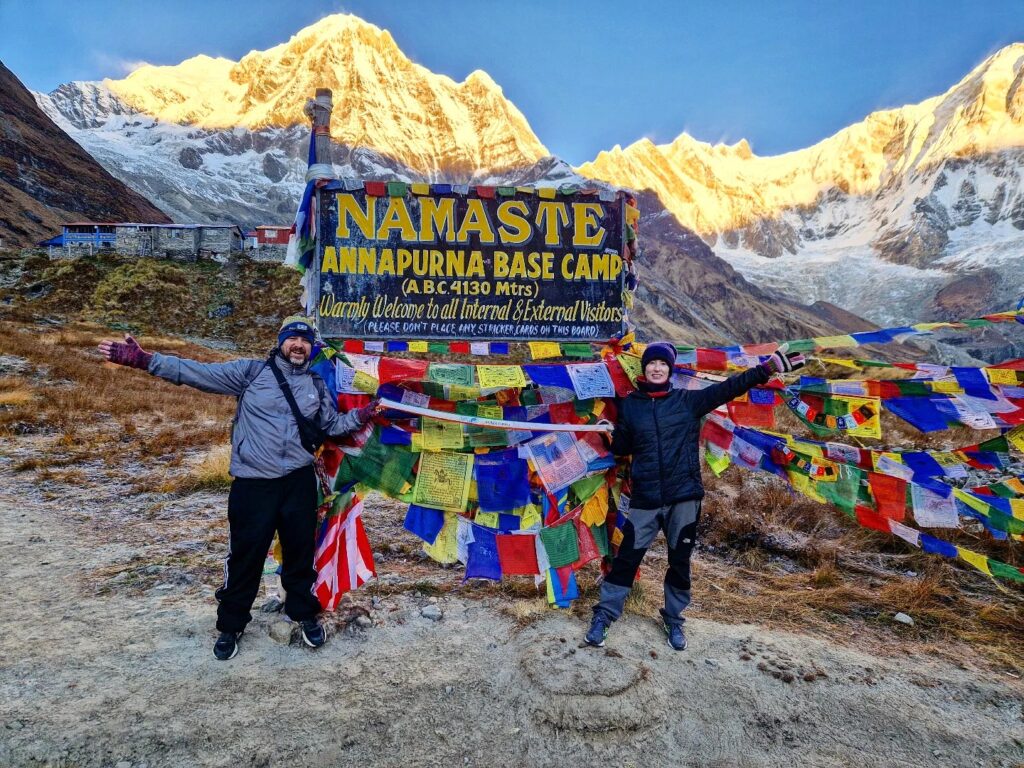
We hope this Nepal travel guide has helped prepare you for your Nepal holiday, allowing you to focus more on enjoying your visit to this remarkable country.
If we have left anything out please let us know. We would love to hear from you.
Feel free to leave a message below or contact us on our socials.
Slán go fóil


This post contains affiliate links. If you click on the links to make a purchase, we will earn a small commission. This is at NO EXTRA COST to you. This is a free way to support us and allow us to continue to create inspiring adventure travel guides.
